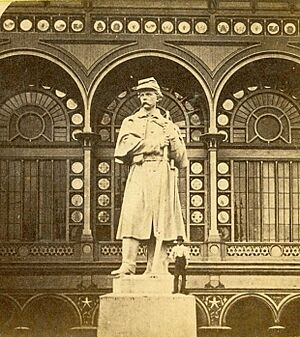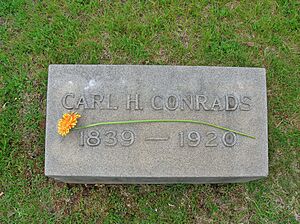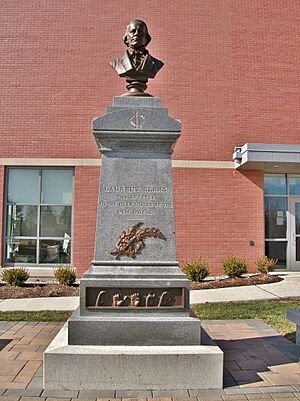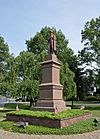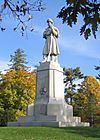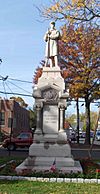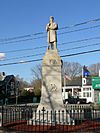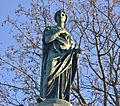Carl Conrads facts for kids
Carl H. Conrads (born February 26, 1839, in Breisig, Germany – died May 24, 1920, in Hartford, Connecticut) was an American sculptor. He is most famous for creating monuments related to the American Civil War. He also has two important statues in the National Statuary Hall Collection at the United States Capitol in Washington, D.C.. People sometimes called him Charles Conrads.
Contents
Carl Conrads' Life Story
Carl Conrads was born in a town called Sinzig-on-the-Rhine in Germany. His father was the mayor there until 1850. In 1853, his parents and brother moved to Texas to become farmers. Carl stayed in Munich, Germany, and studied art at a royal academy.
Moving to America and War Service
Carl moved to New York in 1860. Soon after, he joined the American Civil War as an artilleryman. He served with the 20th New York Volunteers. After the war, in 1866, he moved to Hartford, Connecticut. He started working for James G. Batterson at the New England Granite Works. He worked there until 1903.
What People Said About His Work
In 1879, someone wrote about Carl Conrads:
Another German artist, Carl Conrads, has been for twelve years connected with the Hartford Granite Company [sic]. He is perhaps over-modest regarding his work as a sculptor, which is surely very good of its kind. Among his best designs are the figures on the Antietam Monument. In 1871 he returned to Munich for a short visit, availing himself of the opportunity for still further study. As a designer of monuments, his work stands high.
A famous sculptor and historian named Lorado Taft also praised Carl. He said Carl was a German artist with good training. He was especially good at sculpting with granite.
Carl's Most Famous Sculptures
Some of Carl Conrads' most important granite sculptures include:
- His huge American Volunteer statue. This statue is at Antietam National Cemetery in Sharpsburg, Maryland.
- A seated figure called Morality. This is part of the National Monument to the Forefathers in Plymouth, Massachusetts. This monument is said to be the largest solid granite monument in the world.
- His statue of Alexander Hamilton in Central Park, New York City.
Carl Conrads is buried in West Hartford, Connecticut. His grave has a simple stone marker.
Notable Artworks by Carl Conrads
Here are some of the well-known works created by Carl H. Conrads:
- Oswin Welles Memorial, a bronze figure at Cedar Hill Cemetery, Hartford, Connecticut (1873).
- Bust of Laurent Clerc, at the American School for the Deaf, West Hartford, Connecticut (1874). The base of this statue shows Clerc's name spelled out in sign language.
- Moorhead Column, at Allegheny Cemetery, Pittsburgh, Pennsylvania (1877).
- Alexander Hamilton, in Central Park, New York City (1880). The original plaster model for this statue is at the Museum of American Finance in New York City.
- Joel Thayer Monument, made of granite, in Lake View Cemetery, Skaneateles, New York (1882–83). George Keller was the architect for this monument.
- Colonel Sylvanus Thayer Monument (known as "Father of the Military Academy"), at the U.S. Military Academy, West Point, New York (1883).
- Relief bust of Noah Webster, at the Connecticut State Capitol, Hartford, Connecticut (1885).
- Relief bust of Reverend Horace Bushnell, also at the Connecticut State Capitol, Hartford, Connecticut (around 1885).
- General Henry W. Halleck, in Golden Gate Park, San Francisco, California (1886).
- National Monument to the Forefathers, in Plymouth, Massachusetts (1889). Carl Conrads worked on this with other sculptors and architects.
- Morality (a seated figure), made of granite.
- Embarkation at Delft Haven (a flat, carved plaque), made of marble.
- General John Stark, a bronze statue at the New Hampshire Statehouse, Concord, New Hampshire (1890).
- John B. Ford, a bronze statue in Third Street Park, Ford City, Pennsylvania (1891).
- John Stark from New Hampshire, a marble statue in the National Statuary Hall Collection, United States Capitol, Washington D.C. (1894). This statue is currently in the United States Capitol crypt.
- Daniel Webster from New Hampshire (based on a work by Thomas Ball), a marble statue in the National Statuary Hall Collection, United States Capitol, Washington D.C. (1894).
- Samuel J. Tilden Monument, in the Cemetery of the Evergreens, New Lebanon, New York (1895).
- The Archangel Gabriel, a marble statue on the George H. Thacher Monument, St. Agnes Cemetery, Menands, New York (1896).
- Minute Man, a granite statue in Union Square, Elizabeth, New Jersey (1905).
- Relief bust of Henry Keney, at the Keney Park Entrance Gates, Hartford, Connecticut (around 1905).
Civil War Monuments
Carl Conrads created many monuments to honor soldiers from the American Civil War. Here are some of them:
| Title | Image | Year | Location | Material | Notes |
|---|---|---|---|---|---|
| Soldiers' Monument | 1868 | Granby Green, Granby, Connecticut | Brownstone | George Keller was the architect. | |
| Forlorn Soldier Statue | 1866-1869 | Connecticut State Capitol, Hartford | Brownstone | Made by Batterson's Monumental Works. | |
| Knight Hospital Monument | 1870 | Evergreen Cemetery, New Haven, Connecticut | Granite | Honors 204 Union soldiers who died in the hospital. | |
| Soldiers' Monument | 1872 | Main & Bartlett Streets, Portland, Connecticut | Brownstone | ||
| Soldiers' Monument | 1873 | Meriden City Hall, Meriden, Connecticut | Granite | ||
| The Soldiers' Monument | 1875 | Chelsea Parade Green, Norwich, Connecticut | Granite | Has an eight-sided base. | |
| The American Volunteer (statue), U.S. Soldier Monument | 1876 (Dedicated 1880) | Antietam National Cemetery, Sharpsburg, Maryland | Granite | Conrads was the sculptor, George Keller was the architect. It was shown at the 1876 Centennial Exposition. | |
| Soldiers Monument | 1876 | Courthouse Park, Cortland, New York | Bronze statue, Granite pedestal | Honors those who fought for the Union in 1861-1865. | |
| Soldiers' Monument | 1876 (Dedicated 1877) | Center Park, Manchester, Connecticut | Bronze statue, Granite pedestal | Honors soldiers from Manchester who died in the war. | |
| Wolcottville Soldier's Monument | 1879 | Coe Memorial Park, Torrington, Connecticut | Tan granite | This statue is a smaller copy of The American Volunteer. Made by New England Granite Works. | |
| Soldiers' Monument | 1880 | Town Green, Southington, Connecticut | "White" granite, Blue granite columns | ||
| Soldiers' Monument | 1883 | East Main Street & Broadway Avenue, Mystic in Stonington, Connecticut | Tan granite | Part of the Mystic Bridge Historic District. | |
| Soldiers and Sailors Monument | 1883 | Geneva & Haverling Streets, Bath, New York | Bronze statue | Originally a fountain statue at the New York State Soldiers' and Sailors' Home. | |
| Soldiers' and Sailors' Monument | 1902 | Taunton Green, Taunton, Massachusetts | Granite | ||
| Soldiers' Monument (attributed work) | 1912 | 93 Grove Street, Putnam, Connecticut | Bronze statue, Granite pedestal | ||
| Civil War Monument (attributed work) | 1915-16 | Monument & Smith Streets, opposite Fort Griswold State Park, Groton, Connecticut | Granite | Donated by Robert A. Gray. |
Images for kids
-
Alexander Hamilton, Central Park, New York City (1880).
-
Thayer Monument, U.S. Military Academy, West Point, New York (1883).
-
Around 1888, showing the unfinished National Monument to the Forefathers. You can see Conrads's Morality figure and his Embarkation plaque below it.
-
General John Stark, New Hampshire State Capitol, Concord (1890).
-
John Stark, United States Capitol, Washington, D.C. (1894).
-
Daniel Webster, United States Capitol, Washington, D.C. (1894).
-
Samuel J. Tilden Monument, Cemetery of the Evergreens, New Lebanon, New York (1895).


